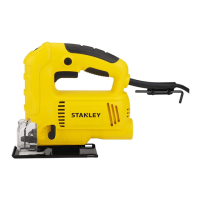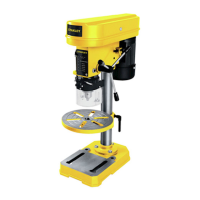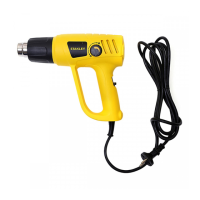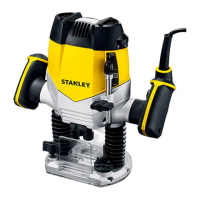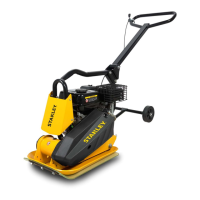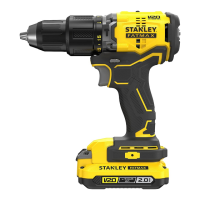23
ENGLISH (Original Instructions)
♦ For continuous operation, press the trigger switch (1),
then press the lock-on button (2).
♦ To switch the tool off, release the trigger switch. To
switch the tool off, when in continuous operation, press
the trigger switch once more and release it.
How to Use the Sightline Feature (Fig. F)
♦ Use a pencil to mark the cutting line.
♦ Position the jigsaw over the line (16).
♦ Viewing from directly above the jigsaw, the line of cut
can be followed easily.
Cutting mode (SJ60 only)
♦ Pendulum stroke or action provides a more aggressive
blade motion and is designed for cutting soft materials
such as wood or plastic. It provides a faster cut, but with
a less smooth cut across the material. Your jigsaw has
a Pendulum Stroke dial. Use of this dial is explained in
the next section.
WARNING! Never use pendulum action to cut metal.
Pendulum Stroke dial (Fig. G - SJ60)
♦ The SJ60 has these four cutting modes with increasing
amounts of pendulum action:
♦ Position 0: metal and aluminium and sheet metal (no
pendulum action).
♦ Position I: for laminates, hard wood, work tops.
♦ Position II: for plywood and PVC/Plastics.
♦ Position III: for soft wood and fast cutting
To adjust the pendulum action (Fig.G):
♦ Rotate the Pendulum Stroke selector (8) to the required
position.
Sawing
Hold the tool firmly with both hands while cutting (Fig.H).
The shoe plate (9) should be held firmly against the
material being cut. This will help prevent the saw from
jumping, reduce vibration and minimise blade breakage.
♦ Let the blade run freely for a few seconds before
starting the cut.
♦ Apply only a gentle pressure to the tool while performing
the cut.
Hints for optimum use
Sawing laminates
When cutting laminates, splintering may occur which can
damage the presentation surface. The most common saw
blades cut on the upward stroke, therefore if the shoe plate
is sitting on the presentation surface either use a saw blade
that cuts on the downward stroke or:
♦ Use a fine-tooth saw blade.
♦ Saw from the back surface of the workpiece.
♦ To minimise splintering, clamp a piece of scrap wood
or hardboard to both sides of the workpiece and saw
through this sandwich.
Sawing metal
WARNING! Do not use a vacuum when cutting metal. Metal
filings will be hot and may cause fire.
Be aware that sawing metal takes much more time than
sawing wood.
♦ Use a saw blade suitable for sawing metal.
♦ When cutting thin sheet metal, clamp a piece of scrap
wood to the back surface of the workpiece and cut
through this sandwich.
♦ Spread a film of oil along the intended line of cut.
Rip Fence (optional)
♦ Ripping and circle cutting without a pencil line are easily
done with a rip fence and circle guide.
Attaching Rip Fence (Figs. I )
♦ Insert rip fence (17) into the shoe plate slots with the
cross bar facing down as shown in figure I.
♦ Place screw (18) into hole in bottom of shoe plate.
♦ Align clamp bar (19) over screw with lipped edge facing
down and pointing towards the rear of the saw.
♦ Using a phillips screwdriver, run the screw into the
threaded hole in the bar clamp as shown in figure G.
♦ Adjust to width of cut and tighten screw.
Circle Cutting (Fig. J)
♦ Insert rip fence into slot on the right side of shoe plate
with cross bar facing up.
♦ Adjust rip fence so that distance from blade to hole in
cross bar is the desired radius and tighten screw.
♦ Place saw so that centre of hole in cross bar is over
centre of circle to be cut (make plunge cut, drill hole for
blade or cut inward from edge of material to get blade
into position).
♦ When saw is properly positioned, drive a small nail
through hole in cross bar into exact centre of circle to
be cut.
♦ Using rip fence as a pivot arm, begin cutting circle.
MAINTENANCE
Your Stanley tool has been designed to operate over a long
period of time with a minimum of maintenance. continuous
satisfactory operation depends upon proper tool care and
regular cleaning.
WARNING! To minimize the danger of serious
personal injury, please switch off the tool power and
disconnect all plugs before adjusting or removing/
installing any accessory. Before reassembling the tool,
press and release the trigger switch to make sure the tool is
already switched off.
WARNING! Before performing any maintenance on corded/
cordless power tools:
Lubrication
Stanley tools are properly lubricated at the factory
and are ready for use.
